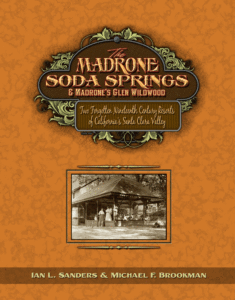Booksmart – Local authors to sign book on history of two Madrone area resorts
It’s the fourth book penned by Mike Brookman and Ian Sanders
Published in the June 13 – 26, 2018 issue of Gilroy Life
 More than century ago, hot-spring spas and resorts brought thousands of people to the South Valley region to relax. Many locals know about the famous Gilroy Hot Springs. Recently, San Martin resident Mike Brookman and Morgan Hill resident Ian Sanders teamed up to produce a new book filled with postcards and other images of the less known but equally fascinating Madrone Soda Spring.
More than century ago, hot-spring spas and resorts brought thousands of people to the South Valley region to relax. Many locals know about the famous Gilroy Hot Springs. Recently, San Martin resident Mike Brookman and Morgan Hill resident Ian Sanders teamed up to produce a new book filled with postcards and other images of the less known but equally fascinating Madrone Soda Spring.
The two local historians sign books at 11 a.m. Saturday, June 16 at Morgan Hill’s BookSmart bookstore featuring “The Madrone Soda Springs & Madrone’s Glen Wildwood: Two Forgotten Nineteenth Century Resorts of California’s Santa Clara Valley.” The picture-filled volume shows what life was like at the famous hot-spring resort located in a canyon in what is now Henry W. Coe State Park. We asked Brookman and Sanders about what they learned in researching their book.
Why did you decide to do a local history book on the Madrone Soda Spring as well as Glen Wildwood?
(Brookman) We’d written three books based on postcards of the local area. Two were specifically about Morgan Hill and one on the Gilroy Hot Springs. The Madrone Soda Springs and the town of Madrone were listed in all of them. In doing the research on the first three books, we learned a lot about Madrone but felt there was also a lot more. We culled postcard collections, personal and institutional collections and came up with a plenty of fascinating and fun material for a book on Madrone.
 Why was Madrone Soda Springs important to the South Valley region?
Why was Madrone Soda Springs important to the South Valley region?
(Sanders) From the late 1850s to 1900, Madrone was the area! Morgan Hill did not exist. Madrone was the economic, social and transportation hub between San Jose and San Martin. Restaurants, shops, a church and school were all located in Madrone. One of the reasons why was because that was where the stage to the popular Madrone Soda Springs recreation area and spa had its terminal. Guests from the metropolitan areas of California would come to Madrone on a train, get off at the station and take the stage coach ride through the eastern foothills of south Santa Clara County to the respite of the mountain resort. The average stay was several days. This brought much needed revenue to South Valley.
Why were mineral springs resorts an important part of 19th century culture — and why did they die off in popularity?
(Brookman) The American Civil War ended in 1865. As at the end of any war, people needed physical and spiritual healing. Mineral spring spas ministered to both and people flocked to them. The Industrial Age had begun and there was more discretionary spending and leisure time to spend it. Medicine was becoming pseudo-science and doctors were recommending that patients “take the waters.” Internal and external application of the chemical rich waters, hot or cold would cure anything and everything. The recreational activities such as hiking, dancing, card and board games, fishing and dancing with family and other guests appealed to the soul. Spas were your one stop for health and the good life.
Unfortunately, as with any fad people began to realize that the actual benefits were not as great as promised. The advent of the automobile age allowed guests to make the trip up and back to the resorts in less than a day and the hotels closed. As the hotels closed, the operating funds dwindled and there were not enough funds for the physical plants at the springs causing most of them to close by the late 1930s.
What is one of your fascinating facts that you learned while researching the book?
(Sanders) We discovered how quickly these once vital sites could wither and disappear from memory and how Madrone played a part in the early struggle for women’s rights. The town of Madrone declined with aggressive promotion by developers in what was to become Morgan Hill. It was gone by 1906 as it was absorbed the neighboring community when it incorporated. Only the name on a few businesses such as the Cribari Winery and nationally famous Madrone Rodeo remained. (We really liked the rodeo. We’re searching for information and artifacts for a possible book on it.) The Madrone Soda Springs struggled along for another 27 years until it was shut down by inattention, neglect and bad press in 1933. The Glen Wildwood Spa were mineral springs on the road to the Madrone Soda Springs. The site is now underneath Anderson Reservoir. It operated as a medical clinic for “women’s complaints” from the early 1890s to 1903. Although there was a wide range of what was diagnosed as women’s complaints at the time, the majority were a discreet reference to abortions. Although not illegal in California at the time, they were socially unacceptable under Victorian mores. Although the patient mortality rate was more than 30 percent in clinical abortions in the 1890s, Glen Wildwood offered women a choice and some control over their lives.
- Results of March 5 primary election show nearly 23 percent SCC voters turn - March 9, 2024
- Mushroom Fest coming back Memorial Day weekend - February 9, 2024
- Garlic Festival seeking sponsorships - February 9, 2024
